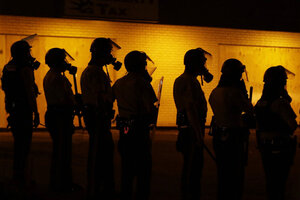Ferguson fallout: Do the police really need 12,000 bayonets?
On Tuesday, the Senate weighed police use of military hardware provided for free by the Pentagon. The program, known as 1033, came to national attention in the wake of the Ferguson protests.

Police wait to advance after tear gas was used to disperse a crowd, on August 17, during a protest for Michael Brown, who was killed by a police officer Aug. 9 in Ferguson, Mo.
Charlie Riedel/AP/File
Washington
Texas police departments own 73 mine-resistant, ambush-protected vehicles. The state’s National Guard has six.
That startling fact was one of many to emerge Tuesday from a congressional hearing into the armed police response to demonstrators in Ferguson, Mo., protesting the Aug. 9 shooting of an unarmed black teenager by a police officer.
At issue was whether local police departments need the sort of heavy-duty equipment provided to them – for free – by the Pentagon. Senators also questioned whether it might be a good idea to also provide training along with the military-grade hardware.
The Pentagon program, known as 1033, came to national attention in the wake of the Ferguson protests, when camouflage-clad police turned up in heavy armored vehicles, aiming high-powered assault rifles at unarmed citizens.
The people who took to the streets to mourn and question the death of 18-year-old Michael Brown, “did not deserve to be treated like enemy combatants,” said Sen. Claire McCaskill (D) of Missouri, who spearheaded the hearing before the Senate Homeland Security Committee.
Nor was the über-armed reaction, which turned Ferguson into a “war zone,” complete with camouflage, tear gas, and laser sites on assault rifles, she added, “compatible with the peaceful exercise of first amendment rights.”
It was a hearing replete with bipartisan agreement.
Sen. Tom Coburn (R) of Oklahoma said that he, too, viewed the police response in Ferguson as treading “on dangerous ground in undermining the very principles that built this country.”
In fact, it’s hard to see the difference, he added, between the Pentagon’s arming of police forces and standing militias.
Into this rare bipartisan accord stepped Alan Estevez, the Pentagon’s principal deputy undersecretary for acquisition, technology, and logistics, who had the unfortunate task of attempting to put the senators’ indignation in context in his testimony before the committee.
Mr. Estevez pointed out that, through its 1033 program, the Pentagon had provided the Ferguson Police Department with a total of two Humvees, one generator, and one cargo trailer. He stressed that the Department of Defense “does not push equipment on any police force.”
In total, the Pentagon has doled out more than $5.1 billion worth of property to police departments since 1990, which has included everything from file cabinets, medical kits, and tools, as well as heavy armored vehicles and weaponry, he said.
The key problem with the program, Estevez readily conceded, is that the Pentagon “does not have the expertise in police force functions, and cannot assess how equipment is used in the mission of an individual law-enforcement agency.”
This concession, and others, did not earn him the favor of lawmakers, however.
Senator McCaskill pointed out that through the 1033 program, Texas police departments have 12 times the number of MRAPs than the state’s National Guard. Similarly, in Florida, local law enforcement has received 45 MRAPs. That state’s National Guard has zero.
“Does that fact make you uncomfortable?” she asked Estevez.
“I believe the Guard will be allocated the force structure they need,” he replied, adding that the police departments get the “older” vehicles, “not the best MRAPs.”
Those, the Pentagon keeps for itself, he noted helpfully.
Senator Coburn questioned why police departments would be given mine-resistant ambush-protected (MRAP) vehicles in the first place.
“An MRAP is a truck,” Estevez argued. “It is not an offensive weapon.”
Senator Coburn begged to differ, and wondered, too, whether it was a good idea for police to be provided with 30-caliber weapons, which shoot bullets with a three-centimeter diameter.
“That’s this big – that’s the size of a shell,” Coburn said, making a circle with his hand in front of his eye.
Sen. Rand Paul (R) of Kentucky was, for his part, particularly puzzled about why 12,000 bayonets have been made available to police departments, and asked Estevez for his thoughts on the matter.
“I cannot answer what use bayonets would be,” Estevez said.
“I can answer it for you,” Senator Paul said. “None.”

